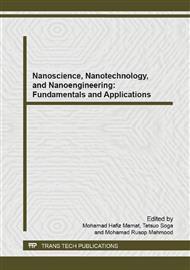[1]
S. Scanlon & A. Aggeli, Self-assembling peptide nanotubes Nanotoday. Vol 3, (2008) no 3-4.
Google Scholar
[2]
Ilya V. Ermakov, guy van der Sande, Jan Danckaert A, Semiconductor ring laser subject to delayed optical feedback: Bifurcations and stability, Commun Nonlinear Sci Numer Simulat 17 (2012) 4767–4779.
DOI: 10.1016/j.cnsns.2012.04.005
Google Scholar
[3]
Kim, A. A, C.S.Yu, H.Y. Yang, J.H.; Baek, I.B.; Ahn, C.G.; Park, C.W.; Jun, M.S.; Lee, S. Ultrasensitive, label-free, and real-time immunodetection using silicon field-effect transistors. Appl. Phys. Lett. (2007).
DOI: 10.1063/1.2779965
Google Scholar
[4]
Martin Hedegård Sørensen, Nanowire Biosensor M.Sc.Eng Thesis, 2009.
Google Scholar
[5]
Gao, A. Agarwal, A. D. Trigg, N. Singh, C. Fang, C-H. Tung, Y. Fan, K. D. Buddharaju& J.Kong Anal. Chem. Silicon Nanowire Arrays for Label-Free Detection of DNA. Z, 79 (2007) 3291– 297.
DOI: 10.1021/ac061808q
Google Scholar
[6]
M. Wesam Al-Mufti1, a, U. Hashim 2, b and Tijjani Adam 3, c, The state of the arts: Simulation of Nanostructures using COMSOL Multiphysics, Vol 832 (2014) pp.206-211 Trans Tech ublications.
DOI: 10.4028/www.scientific.net/amr.832.206
Google Scholar
[7]
U. Hashim, N.Hamat N.H, Siti Fatimah, Tijjani Adam. Thermal Diffusion: A Simulation Based Study on Shallow Junction Formation. Int. J. Nanoelectronics and Materials 5 (2012)77-86.
Google Scholar
[8]
S Dhahi, U Hashim, M E Ali, Less than 10-nm Gap Silicon and Polysilicon Electrodes for Sensing pH and Yeast Concentration. Current Nanoscience 8 (6) (2012)925-929.
DOI: 10.2174/157341312803988971
Google Scholar
[9]
Hashim, U., Diyana, P.N.A., Adam, T, Numerical simulation of microfluidic devices. Journal of Applied Sciences Research. 8 (4) pp (2012) 2162-2174.
Google Scholar
[10]
B.Sharma Rao, U.Hashim, T.S. Dhahi, Tijjani Adam, DI Water Electrical Characteristics monitoringusing in House Fabricated Polysilicon Nanoelectrode Based Transducer. International Journal of Enhanced Research in Science Technology & Engineering. Vol. 1 Issue 1 (2012) pp.1-6.
DOI: 10.1109/iecbes.2012.6498063
Google Scholar
[11]
A. Wesam Al-Mufti, U. Hashim & Tijjani Adam, Effect of electric potential into conductance silicon nanowire distribution, Microsystem Technologies. DOI 10.1007/ (2014) s00542-014-2149-0
DOI: 10.1007/s00542-014-2149-0
Google Scholar


